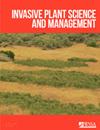常见观赏地被植物卫矛入侵蔓延的遗传分析
IF 1.2
4区 生物学
Q3 PLANT SCIENCES
引用次数: 0
摘要
一些外来物种在美国成为入侵物种的重要途径是通过园艺。一种这样的植物是卫矛(土耳其)。Hand.-Maz。它是一种常绿地被植物,有超过52种不同的园艺品种,在美国中西部的许多植物苗圃和花园中心仍有出售。虽然有几个州已经承认福尔图尼是一种入侵物种,但尚不清楚它是如何从种植中逃脱的,甚至不知道传播种群的身份,包括是否涉及杂交或栽培。利用共显性微卫星标记,我们在俄亥俄州、肯塔基州、堪萨斯州和明尼苏达州取样了多个入侵种群,并将它们的基因型与市售品种进行了比较,以确定传播是如何发生的。从入侵种群中收集的所有样本在基因上都是相同的,并且与唯一表现出多倍体的品种“Coloratus”完全匹配。这些数据还表明,福特尼可能通过无融合繁殖和/或通过繁殖体片段进行无性繁殖,这可以在群体中快速固定有利的基因型。为了遏制持续的侵入性传播,我们建议将“Coloratus”从商业销售和分销中移除。我们还建议土地管理者、园艺和园林绿化企业以及政府机构仔细监测其他卫矛品种的入侵潜力和传播。本文章由计算机程序翻译,如有差异,请以英文原文为准。
Genetic Analysis of Invasive Spread of Euonymus fortunei (Wintercreeper), a Popular Ornamental Groundcover
ABSTRACT An important route of introduction of some non-native species that subsequently become invasive in the United States is through horticulture. One such plant is Euonymus fortunei (Turcz.) Hand.-Maz., commonly known as wintercreeper, an evergreen groundcover with over 52 different horticultural varieties and which is still sold at many plant nurseries and garden centers in the Midwestern United States. Although several states have recognized E. fortunei as an invasive species, it is unknown how its escape from cultivation has occurred and even the identity of spreading populations, including whether hybrids or cultivars are involved. Using codominant microsatellite markers, we sampled multiple invasive populations in Ohio, Kentucky, Kansas, and Minnesota, and compared their genotypes with commercially available cultivars to determine how spread has occurred. All samples collected from invasive populations were genetically identical to one another and matched perfectly with the ‘Coloratus’ cultivar, the only cultivar to exhibit polyploidy. The data also suggests that E. fortunei may potentially reproduce via apomixis and/or clonally through propagule fragments, which can quickly fix favorable genotypes within a population. To curb continued invasive spread, we suggest that ‘Coloratus’ be removed from commercial sale and distribution. We also propose that land managers, horticultural and landscaping businesses, and governmental agencies carefully monitor other Euonymus cultivars for invasive potential and spread.
求助全文
通过发布文献求助,成功后即可免费获取论文全文。
去求助
来源期刊

Invasive Plant Science and Management
PLANT SCIENCES-
CiteScore
2.20
自引率
9.10%
发文量
24
审稿时长
6-12 weeks
期刊介绍:
Invasive Plant Science and Management (IPSM) is an online peer-reviewed journal focusing on fundamental and applied research on invasive plant biology, ecology, management, and restoration of invaded non-crop areas, and on other aspects relevant to invasive species, including educational activities and policy issues. Topics include the biology and ecology of invasive plants in rangeland, prairie, pasture, wildland, forestry, riparian, wetland, aquatic, recreational, rights-of-ways, and other non-crop (parks, preserves, natural areas) settings; genetics of invasive plants; social, ecological, and economic impacts of invasive plants and their management; design, efficacy, and integration of control tools; land restoration and rehabilitation; effects of management on soil, air, water, and wildlife; education, extension, and outreach methods and resources; technology and product reports; mapping and remote sensing, inventory and monitoring; technology transfer tools; case study reports; and regulatory issues.
 求助内容:
求助内容: 应助结果提醒方式:
应助结果提醒方式:


